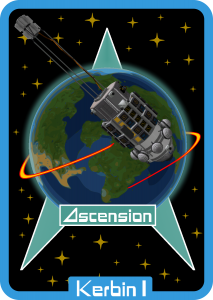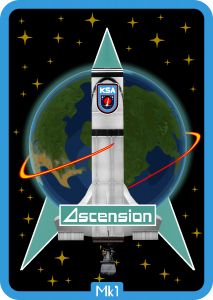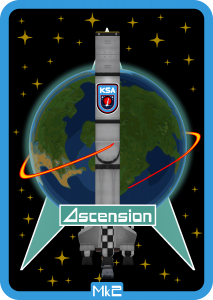|
Category Archive: News
May 25 2020
Operations Summary – Weeks of 5/11 & 5/18/20
Apr 21 2020
Kerbin I Mission Analysis
 Originally conceived in 2018 and planned to launch aboard an Ascension Mk1 in 2019, when that rocket was deemed unable to make orbit the payload was delayed and eventually committed to the Ascension Mk2, which was not able to fly until early 2020. The purpose of our first orbital satellite was to place our mission control team in charge of actual orbital operations, test the new Archtagon Aerospace RB-8 cold gas engine, test the new Probodobodyne OKTO common probe core and perform one final re-entry/impact test of the radioisotope thermoelectric generator (RTG). The probe carried a massive bank of batteries because the RTG remained non-functional, allowing for the probe to stay up in orbit for several days with the use of hibernation to save power. The mission got off to an uncertain start when the Viklun upper stage placed the satellite into an unstable orbit, leaving the team on the ground with the challenge of recovering the situation to still carry out the previously-stated mission objectives.
Originally conceived in 2018 and planned to launch aboard an Ascension Mk1 in 2019, when that rocket was deemed unable to make orbit the payload was delayed and eventually committed to the Ascension Mk2, which was not able to fly until early 2020. The purpose of our first orbital satellite was to place our mission control team in charge of actual orbital operations, test the new Archtagon Aerospace RB-8 cold gas engine, test the new Probodobodyne OKTO common probe core and perform one final re-entry/impact test of the radioisotope thermoelectric generator (RTG). The probe carried a massive bank of batteries because the RTG remained non-functional, allowing for the probe to stay up in orbit for several days with the use of hibernation to save power. The mission got off to an uncertain start when the Viklun upper stage placed the satellite into an unstable orbit, leaving the team on the ground with the challenge of recovering the situation to still carry out the previously-stated mission objectives.
The Mission
Deployment to begin the mission was carried out once the Viklun stage came back into communications range of the ground via its more powerful 1.5Mm antenna. Having run out of power about an hour prior to this, it had been leeching electrical charge from Kerbin I’s battery banks to keep itself alive. Although Kerbin I only carried a 500km antenna, deployment was planned for now because afterwards Kerbin I could go into hibernation, conserving energy over the time it would have spent coming within its own comms range. The Viklun stage had enough residual power after separation it could continue to relay signal while Kerbin I transitioned into hibernation, after which the Viklun became derelict. How it fared after this can be read about in the Ascension Mk2 Flight 1 analysis.
Apr 07 2020
Ascension Mk1 Flight 12 Analysis
 Captain Jebediah has waited nearly 5 months for his second chance to fly into space after his first attempt last year was foiled by religious extremists. Extensive training with his backup crew mate Specialist Bob prepared him to handle everything but the wait, which was increased further on his second attempt first by weather delays and then by a faulty engine on launch day. After successful ignition, launch failed due to low thrust issues that caused the engine to not reach a thrust to weight ratio (TWR) of 1.2 for lift off. Trying a second time led to the same result. Although the thrust loss was minimal and still would have been enough to push the rocket off the pad, downrange performance was called into question – it would have been a costly and embarrassing failure if the rocket had been unable to reach space due to thrust issues. Thankfully this additional mission delay was not as long as it could have been since we had another engine that was recently received & tested ready to swap in over the course of a week. After a static fire on the pad the day before launch to make double sure it was capable, Jeb was finally able to ride up into the starry blackness. His mission would be similar to the previous kerbed sub-orbital flights in allowing the gathering of medical data from the 0G environment as well as providing additional flight data on the performance of the capsule, heat shield and crew G tolerances. And as always – amazing pictures!
Captain Jebediah has waited nearly 5 months for his second chance to fly into space after his first attempt last year was foiled by religious extremists. Extensive training with his backup crew mate Specialist Bob prepared him to handle everything but the wait, which was increased further on his second attempt first by weather delays and then by a faulty engine on launch day. After successful ignition, launch failed due to low thrust issues that caused the engine to not reach a thrust to weight ratio (TWR) of 1.2 for lift off. Trying a second time led to the same result. Although the thrust loss was minimal and still would have been enough to push the rocket off the pad, downrange performance was called into question – it would have been a costly and embarrassing failure if the rocket had been unable to reach space due to thrust issues. Thankfully this additional mission delay was not as long as it could have been since we had another engine that was recently received & tested ready to swap in over the course of a week. After a static fire on the pad the day before launch to make double sure it was capable, Jeb was finally able to ride up into the starry blackness. His mission would be similar to the previous kerbed sub-orbital flights in allowing the gathering of medical data from the 0G environment as well as providing additional flight data on the performance of the capsule, heat shield and crew G tolerances. And as always – amazing pictures!
Mar 25 2020
Ascension and Progenitor Programs Suspending Operations
 Today I made the decision to suspend our rocketry programs for a full review and reassessment on all levels (design, administration, operations, vehicle integration, etc) over the next two months, at least. This move is especially difficult because we started this year out so strong, putting a probe into orbit and once again sending a kerbal up into space after a 5 month hiatus of crewed flight. This month we were also due to launch the first Progeny Mk7-B rocket and begin testing booster recovery and re-use. However despite the increasing momentum we seem to be surpassing our capacity to manage the increasing complexity of our missions and run the risk of compromising safety.
Today I made the decision to suspend our rocketry programs for a full review and reassessment on all levels (design, administration, operations, vehicle integration, etc) over the next two months, at least. This move is especially difficult because we started this year out so strong, putting a probe into orbit and once again sending a kerbal up into space after a 5 month hiatus of crewed flight. This month we were also due to launch the first Progeny Mk7-B rocket and begin testing booster recovery and re-use. However despite the increasing momentum we seem to be surpassing our capacity to manage the increasing complexity of our missions and run the risk of compromising safety.
Initial review of the recent kerbed mission has found out why the rocket did not travel as high as planned – it was 53kg heavier than expected. We don’t have a scale that can measure a rocket after it’s been fully assembled. We know the mass of a rocket because we know the mass of all the individual parts plus the mass of the fuels and the mass of the crew. At some point in this mission improper mass figures were given to the mission design team, or proper ones were given but then failed to be updated when changes were made to the rocket’s assembly. We’re still working down the fault chain to identify all the reasons why this mass discrepancy occurred.
Although this was a relatively minor mistake that did not lead to any actual issues with the mission itself, ignoring it could lead to larger mistakes that in turn lead to disastrous consequences. I don’t feel that it is enough to recognize the issue and say “we’ll get it fixed” as we also continue to move on with operations that may already be compromised. Shutting everything down will allow us to go back to missions and vessels already in progress of being deployed to ensure that they are properly put together.
This decision is also influenced by the recent shut down of the Genesis program, which allowed us to identify and rectify numerous issues that had creeped their way into the program over the years. While we haven’t yet lost a pilot in Genesis due to maintenance or operational errors, there have been numerous close calls and the margins for crewed rocket flight are even tighter, not to mention how much more expensive it is to lose a rocket and unkerbed payload in flight.
This shut down will affect launches and construction only at this time. Engine testing on our static stands will continue and Wernher von Kerman’s team over at R&D also remain unaffected, so some things will continue to move forward. The Progeny Mk7-B that was recently assembled will receive another thorough inspection, mission plans for it and future Mk7-B flights will undergo full reviews. The recent Ascension Mk1 flight will continue to be analyzed and a report published. The upcoming Ascension Mk1 and Mk2 missions are all undergoing the same review scrutiny and we will also be taking another look at what we need to accomplish between now and the late-2021 launch of the first Extremis mission. Crew training will be suspended so our astronauts can be involved in the review aspects oriented towards their mission preparations – we expect training exercises to resume prior to the operational suspension being lifted.
Lead Engineer Simon and Flight Director Lanalye are both in agreement with me on this decision and we are confident that this will work to ensure we finish this year as strong as we started.
– Drew Kerman
Founder, Operations Director
Mar 19 2020
Ascension Mk2 Flight 1 Analysis
 Originally introduced as the Ascension Mk1 Block II back in March 2018, this rocket was meant to be the heavy-lift variant to the orbital Block I, using as many as 4 solid rocket motors to help it get going off the pad with larger payloads. Eventually however as the Block I showed it didn’t have the power to reach orbit the Block II was shelved and the following year brought back as the Mk2 with the addition of the Viklun upper stage. The rocket was originally set to fly in late 2019 until doubts began to creep in about the performance of the new guidance fins in being able to turn the rocket over enough for a shallow orbital ascent. A test flight with the Mk1 was set for the end of the year instead but that was forced back into early 2020 when the KSC was attacked and the launch pad damaged. All this and more details can be reviewed in the mission timeline, which includes tweets dating back to the Ascension program’s inception in 2017. Having over two years to prepare for the launch of this rocket, very little issues were had in the final lead-up to its mission. The rocket was rolled out atop the Mobile Launch Platform and all three service towers were finally used, with the lower booms providing fuel to the two stages and the crew access extension giving power to the Viklun and Kerbin I probe cores. The 1.25m computer core of the Viklun stage is the first of its size and would guide the rocket during ascent using its extra space to hold two discrete CPUs for cross-check and redundancy.
Originally introduced as the Ascension Mk1 Block II back in March 2018, this rocket was meant to be the heavy-lift variant to the orbital Block I, using as many as 4 solid rocket motors to help it get going off the pad with larger payloads. Eventually however as the Block I showed it didn’t have the power to reach orbit the Block II was shelved and the following year brought back as the Mk2 with the addition of the Viklun upper stage. The rocket was originally set to fly in late 2019 until doubts began to creep in about the performance of the new guidance fins in being able to turn the rocket over enough for a shallow orbital ascent. A test flight with the Mk1 was set for the end of the year instead but that was forced back into early 2020 when the KSC was attacked and the launch pad damaged. All this and more details can be reviewed in the mission timeline, which includes tweets dating back to the Ascension program’s inception in 2017. Having over two years to prepare for the launch of this rocket, very little issues were had in the final lead-up to its mission. The rocket was rolled out atop the Mobile Launch Platform and all three service towers were finally used, with the lower booms providing fuel to the two stages and the crew access extension giving power to the Viklun and Kerbin I probe cores. The 1.25m computer core of the Viklun stage is the first of its size and would guide the rocket during ascent using its extra space to hold two discrete CPUs for cross-check and redundancy.
The Flight
Although no issues presented themselves during pre-flight a hold from the weather desk was called during the L-5min final general polling due to upper-level winds being outside launch commit limits. We had to be more careful than usual with upper-level conditions because of the large interstage in this rocket that could literally see it ripped in two if the upper stage strikes heavy winds going in one direction while the lower stage experiences winds in a different direction, an event known as shear. While the winds appeared to be trending downwards in the data received from the weather balloon, we couldn’t be sure whether it would continue. Having the entire daylight window available to us however a second balloon was launched to find out.







